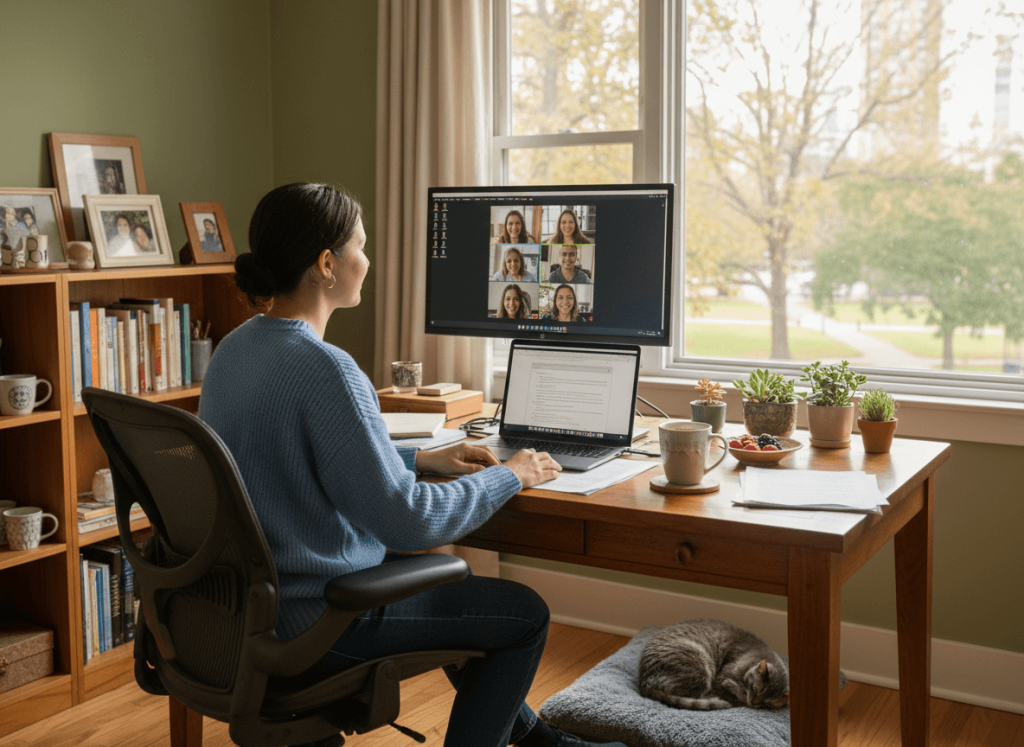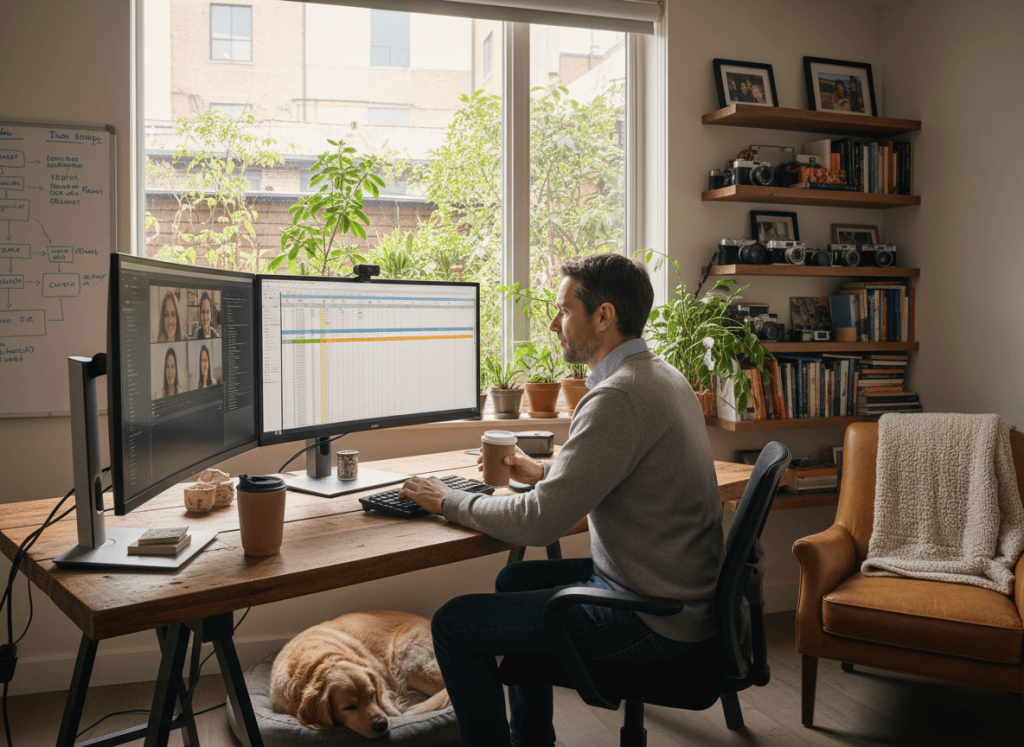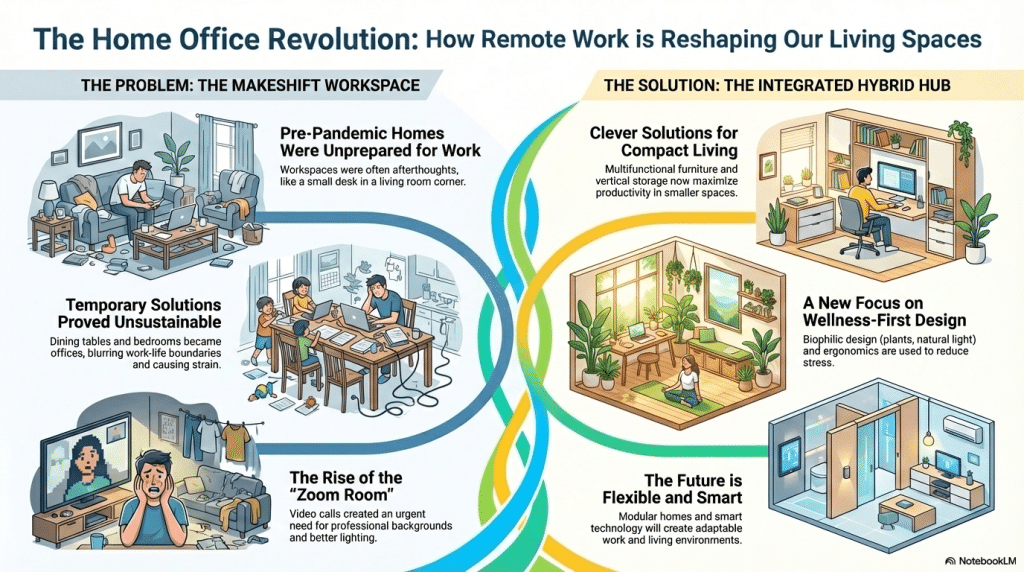The way we live and work has fundamentally changed, and our homes are evolving to keep up. Once designed purely for residential purposes, our homes are now dynamic hubs that serve multiple roles, including functioning as workplaces. The rise of remote work has completely redefined home design, transforming traditional spaces into functional, inspiring environments that support our professional lives.
Read on as we’ll explore how remote work is reshaping home design, from the creation of dedicated workspaces to innovative, multifunctional solutions that make even the smallest spaces more productive and livable. Let’s dive into this shifting home paradigm and uncover how our living spaces are adapting to meet the demands of modern work-life balance.
Table of Contents
- The Shifting Home Paradigm
- The Rise of the Hybrid Hub
- Clever Design Solutions for Compact Living
- The Wellness-First Workspace
- The Future of Flexible Living
- Related Questions
The Shifting Home Paradigm
Remember the Pre-Pandemic Home?
Before the pandemic, homes were primarily designed for living, resting, and entertaining. Workspaces, if they existed at all, were often an afterthought—perhaps a small desk tucked into a bedroom or a corner of the living room.
Then came the global shift to remote work. What began as a temporary solution quickly revealed itself to be a permanent transformation. Remote work wasn’t just a trend; it was a revolution. Suddenly, our homes needed to accommodate not just our personal lives but also our professional ones.
The Unexpected Shift
This shift placed unprecedented demands on our living spaces. Dining tables became makeshift desks, bedrooms doubled as conference rooms, and quiet corners became the most coveted real estate in the house. But as the months turned into years, it became clear that these temporary solutions weren’t sustainable. Homes needed to evolve—and fast.
From dedicated home offices to flexible, multipurpose zones, our homes adapted to this new reality. This transformation wasn’t just about creating functional workspaces; it was about rethinking how we live and work in harmony.

The Rise of the Hybrid Hub
No More Cramped Corners
Gone are the days when a home office meant squeezing a desk into an unused corner. Designers are now prioritizing distinct work zones that are seamlessly integrated into the home. These spaces are designed to be functional without compromising on aesthetics, blending into the overall design of the home while still offering a professional environment.
The “Zoom Room” Phenomenon
The rise of video conferencing brought about the “Zoom Room” phenomenon. Suddenly, having a clean, professional background and optimized lighting became non-negotiable. Home offices began to feature curated backdrops, from bookshelves to statement art pieces, and lighting was carefully chosen to ensure you looked your best on camera.
Beyond the Desk
Modern home offices are about more than just a desk and chair. They’re designed to transition seamlessly between work and relaxation. This might mean incorporating a cozy reading nook, designing spaces that can double as guest rooms, or using furniture that serves multiple purposes. The goal is to create a space that supports productivity during the day and relaxation in the evening.

Clever Design Solutions for Compact Living
For those living in smaller homes or apartments, creating a functional home office can be a challenge. But with a little creativity, even the smallest spaces can be transformed into productive work zones.
Multifunctional Furniture
One of the biggest trends in compact living is multifunctional furniture. Think beds that fold into desks, dining tables that double as conference surfaces, and storage units that transform into workstations. These innovative solutions make it possible to maximize every inch of space without sacrificing functionality.
Acoustic Considerations
Noise is one of the biggest challenges of working from home, especially in smaller spaces. Designers are now incorporating acoustic solutions, such as soundproof panels, noise-canceling curtains, and strategic layouts that minimize background noise. These features help create a quieter, more focused work environment.
Vertical Integration
When floor space is limited, the only way to go is up. Vertical integration involves using walls for built-in storage, shelving, and even fold-out desks. This not only saves space but also keeps your work area organized and clutter-free, which is essential for productivity.
The Wellness-First Workspace
As remote work becomes the norm, there’s a growing emphasis on creating home offices that prioritize wellness. After all, a healthy workspace is a productive workspace.
Biophilic Design
Biophilic design, which incorporates natural elements into the home, has become a major trend in home office design. This might include adding plants, maximizing natural light, or using organic textures like wood and stone. These elements not only enhance the aesthetic appeal of your workspace but also promote focus and reduce stress.
Ergonomics Redefined
Spending long hours at a desk can take a toll on your body. That’s why investing in ergonomic furniture is essential. Adjustable desks, supportive chairs, and monitor stands are just a few of the features that can help you maintain good posture and avoid long-term health issues.
Mindfulness in Design
A well-designed home office should also promote mental well-being. Calming aesthetics, such as neutral color palettes, soft lighting, and clutter-free layouts, can help reduce stress and enhance concentration. Some people are even incorporating meditation corners or relaxation zones into their home offices to encourage mindfulness throughout the day.

The Future of Flexible Living
As remote work continues to evolve, so too will our homes. Here’s a glimpse into the future of home design:
Modular Homes
Modular homes, which are designed to be easily reconfigured, could become the norm. These adaptable structures allow homeowners to change the layout of their space as their needs evolve.
For example, a guest room could be transformed into a home office, or a living room could be reconfigured to include a dedicated work zone.
Smart Home Integration
Technology is playing an increasingly important role in home design. Smart home systems can optimize lighting, temperature, and connectivity, creating a seamless transition between work and leisure. Imagine a workspace that automatically adjusts the lighting and temperature based on the time of day or a desk that raises and lowers itself based on your schedule.
The “Workation” Impact
Remote work has blurred the lines between travel and professional life, giving rise to the “workation” trend. This has influenced the design of second homes, which are now being equipped with high-speed internet, dedicated workspaces, and other features that support remote work.
Whether it’s a beach house or a mountain cabin, these homes are designed to offer the perfect balance of work and relaxation.
The way we live and work has undergone a seismic shift, and our homes are catching up. Remote work has redefined home design, transforming traditional spaces into functional, inspiring environments that support both our personal and professional lives.
From dedicated offices to flexible, multifunctional zones, the modern home is a hybrid hub that adapts to our changing needs. By incorporating clever design solutions, prioritizing wellness, and embracing technology, we can create spaces that enhance productivity, promote well-being, and make remote work a seamless part of our lives.
So, if your home office is still just a corner of your living room, it might be time to rethink your space. The future of home design is here, and it’s all about creating environments that support the way we live and work today.
Real Estate Crunch gives you real property and real estate information and advice. We offer a free monthly newsletter; you can sign up for our newsletter by clicking here.
We also have a weekly podcast called “Real Estate Crunch,” found on all major podcast platforms. Listen to our podcast by clicking here.
Follow us on our social media platforms – Facebook and Instagram.
Related Questions
Why Are Tiny Homes Illegal?
Many states are starting to regulate tiny homes or make most tiny houses illegal. But this, of course, can change from state to state, city to city, and county to county. The best way to know whether or not a tiny home is allowed on your land is to go to your local municipality and ask them what the zoning regulations are and any building code requirements.
By clicking here, you can read more about Why Are Tiny Homes Illegal?
What Is The Difference Between Personal And Private Property?
Under the law, personal property is defined as anything which can be moved. In other words, a car would be considered your personal property. On the other hand, private property is any property not owned by the government, city, county, or federal agency.
By clicking here, you can read more about What Is The Difference Between Personal And Private Property?
Can You Legally Live In A Commercial Property?
You cannot live in a property that is zoned as a commercial property. Zoning laws in places like the United States are pretty strict. They usually fall under the state and also county and municipality jurisdictions. To legally live in commercial property and to make that property your residence, it should be lawfully zoned as residential property or what is known as a mixed zone property.
By clicking here, you can read more about Can You Legally Live In A Commercial Property?


Leave a Reply
You must be logged in to post a comment.